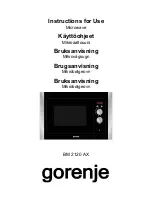
InstallatIon
InstructIons
over the range
Microwave oven
E
MountInG sPacE
This Over the Range Microwave Oven requires a mounting space
on a wall as shown in Figure 1. It is designed to be used with
standard 12" wall cabinets.
Before You Begin
•
IMPortant
Save these instructions for local
inspector’s use.
•
IMPortant
Observe all governing codes and
coordinates.
•
note to installer
– Be sure to leave these
instructions with the Consumer.
•
note to Consumer
– Keep these instructions for
future reference.
•
skill level
– Installation of this appliance requires
basic mechanical and electrical skills.
• Proper installation is the responsibility of the installer.
• Product failure due to improper installation is not covered
under the Warranty.
• Please read all instructions thoroughly before installing
the Over the Range Microwave Oven. Two people are
recommended to install this product.
• If a new electrical outlet is required, its installation should
be completed by a qualified electrician before the Over the
Range Microwave Oven is installed. See 3 ELECTRICAL
GROUNDING INSTRUCTIONS on page 2.
Read these instructions completely and carefully.
2 Wall constructIon
This Over the Range Microwave Oven should be mounted against
and supported by a flat vertical wall. The wall must be flat for proper
installation. If the wall is not flat, use spacers to fill in the gaps. Wall
construction should be a minimum of 2" x 4" wood studding and
3/8" or more thick dry wall or plaster/lath. The mounting surfaces
must be capable of supporting weight of 110 pounds—the oven
and contents—AND the weight of all items which would normally
be stored in the top cabinet above the unit.
the unit should be attached to a minimum of one 2" x 4" wall
stud.
To find the location of the studs, one of the following methods may
be used:
A. Use a stud finder, a magnetic device which locates the nails in
the stud.
B. Use a hammer to tap lightly across the mounting surface to
find a solid sound. This will indicate stud location.
The center of the stud can be located by probing the wall with a
small nail to find the edges of the stud and then placing a mark
halfway between the edges. The center of any adjacent studs will
normally be 16" or 24" to either side of this mark.
nEEd HElP?
For customers in the United States, call: 1-800-944-9044
For customers in Canada, call: 1-800-213-9397 (English)
1-800-668-4606 ext.8199 (French)
rEad carEfully. KEEP tHEsE InstructIons.
P/N 316495006
TINSEB484MRR0
Backsplash
Figure 1
15.5"
30" or more
from cooking
surface
66" or more
from floor
30"
At least 2"
12"


































